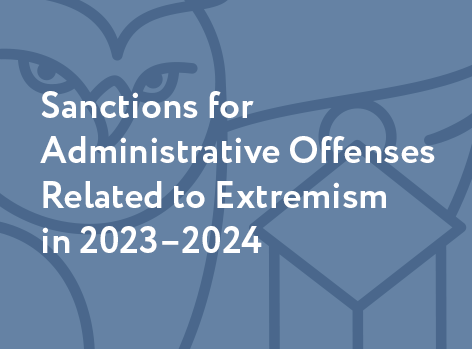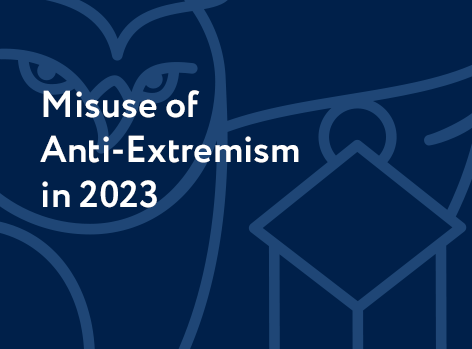Prosecutorial bias and opacity are the main shortcomings of the legal process under Articles 280 and 205.2 of the Criminal Code (CC).
The Supreme Court statistics indicate an increase in the number of those convicted for incitement to extremist activities (Article 280 CC) or for incitement to terrorism, its justification and propaganda (Article 205.2 CC). The number of convicted offenders with a primary charge under Article 280 CC reached 113 people in 2016 and decreased to 90 in 2018, but has been increasing steadily since then – in 2021, their number already reached 255. The number of convicted offenders with a primary charge under Article 205.2 CC, has grown steadily over ten years and reached 199 people in 2021. Several dozen additional people last year had one of these articles as an additional charge on their sentences. The number of sentences under Article 282 CC (inciting hatred or enmity) has also been growing. This article almost disappeared from judicial statistics by 2020, when it was found in sentences of only 18 people, but in 2021, the number rose to 50; most of the offenders were convicted under a criminal rather than administrative article because they were charged with inciting hatred with the threat of violence.
SOVA Center has at least some information, that is, a general understanding of factual allegations, for only about half of the verdicts under Article 280 and a third of the verdicts under Article 205.2 issued in 2021. The data is not available since court websites almost never publish the texts of sentences in extremist and terrorist cases. This practice arose from the broadly interpreted ban on publishing the texts of judicial acts issued in cases “affecting the security of the state.”[1]
Alas, in many cases when some information becomes available, it is completely insufficient for assessing the appropriateness of a sentence.
Here we must recall the general principles that guide SOVA Center in evaluating the appropriateness of cases on such charges. As much as we criticize the definitions and norms related to the concepts of “extremism” and “terrorism” in Russian legislation, we believe that in certain cases the state, in accordance with the norms of international law and the Russian constitution, can prosecute public statements that constitute socially dangerous incitement. This, no doubt, refers to some acts that can be qualified under Articles 280 and 205.2 CC, but it is also indisputable that in quite a few cases the incriminated statements did not, in fact, constitute socially dangerous incitement.
Our “Misuse of Anti-Extremism” section includes the news only about the cases, in which we are sure that public danger was non-existent or clearly insufficient for criminal prosecution. Verdicts in these cases are entered into the database of verdicts on our website and are marked “no” in the “Appropriateness” column. Our “Racism and Xenophobia” section covers the cases of public statements related to nationalism and xenophobia, and, if we believe that the public danger of these statements merited criminal prosecution, the relevant verdicts are entered into the database and marked “yes” in the “Appropriateness” column. Sometimes the information we have is insufficient for us to form an opinion – such cases are not covered in our news releases, and the verdict is entered into the database with “unknown” in the indicated column. It also happens that the charges are brought in connection with several different episodes under a number of articles, and seem partially justified – we describe such cases in our news, and mark the relevant verdicts as “unsure.” If we recognize the court's decision as generally appropriate even though the alleged activities were unrelated to nationalism and xenophobia, such verdicts are marked as “other,” and the news about them is not published on the website. The latter cases primarily involve propaganda of violence against government officials.
It is important to emphasize that in the cases where we know the charges only partially and cannot estimate the social danger of the statement, but we know that it contained incitement to violence, the sentence will not be classified as inappropriate. We are especially scrupulous in such situations. However, in the absence of information about the clearly xenophobic character of the statements in question, we will not mark a verdict as appropriate either.
In general, the state can and should condemn calls for violence except in cases provided for by law (for example, but not exclusively, in case of necessary defense). However, condemnation does not necessarily have to be expressed in the form of criminal prosecution. To distinguish between appeals that need to be restricted and the merely reprehensible ones, international law (starting with the UN pacts such as, for example, Article 19 of the International Covenant on Civil and Political Rights) establishes criteria that are sometimes combined into the so-called three-part test:
- a restriction on freedom of expression must have an aim, specified by international law, such as protecting public order and national security; other aims are not legitimate;
- this restriction must be prescribed by law (including requirements for the clarity and comprehensibility of the legal norm not always fulfilled in our country);
- this restriction must be necessary to achieve the established goal, that is, a restriction should meet a criterion of proportionality to the perceived threat posed by a public statement; the restrictions, of course, also include criminal prosecution.
Russian courts believe that legislators already complied with the first two parts of the test and rely on the letter of the criminal (or other) law, although international courts, such as the ECHR, view the situation differently. We believe that, at least in terms of incitement to violence, Russian criminal norms are generally adequately worded, and therefore, we also rarely discuss the first two parts of the three-part test. On the other hand, we ponder the question of the proportionality of punishment quite often, including the appropriateness of criminal prosecution per se. Unfortunately, the same cannot be said about our courts – their verdicts rarely address proportionality.
Meanwhile, international experts have developed a more detailed six-part test, approved by the UN Human Rights Council, for a particular type of socially dangerous appeals – incitement to hatred based on several group characteristics. Moreover, the explanations of the Supreme Court issued in 2018 and 2021 on the application of Criminal Code Articles 282, 280 and 280.1 (calls to violate the territorial integrity of Russia) almost completely reproduce the provisions of this test. We believe that the six-part test can be used practically unchanged to assess public danger of other types of public statements.
Here are the criteria that the six-part test suggests considering:
- The content of the statement (including its form and style);
- The identity of a speaker (their authority with their intended audience);
- Context, including broad socio-historical context (certain topics may be more or less painful in a particular society, for example, due to recent historical events) and local, communicative context of the statement (it could be a public speech, a manifesto, a private but open dispute, etc., the statement could be made in a peaceful environment, in a war situation, in a situation that could result in a pogrom, etc.);
- Direction of the statement (there must be a clear intent);
- Extent of the speech act (this factor is particularly important for online statements, but, in addition to the actual and expected audience size, it is important to take into account the nature of the audience, for example, their openness to certain kinds of appeals);
- The likelihood of serious consequences (such consequences do not have to actually occur, and, in general, a person is responsible for their words, and not for other people's actions, but the likelihood of consequences should nevertheless be taken into account).
Having considered the situation in the light of the six-part test, the court – and the investigation before it – can sometimes dismiss the case altogether, and if not, take all these parameters into account when sentencing.
Judging by the verdicts that we continue to see, the courts are not always guided by these, quite reasonable, criteria, although they do not completely neglect them either. Thus, in recent years, more attention has been paid to the previously completely ignored criterion of audience size. Although problems are still present in this area, and not only in terms of the technical assessment of the audience – for example, a statement could have spread widely thanks to reposts and links made by other people, while the offender would not have reached a significant audience on their own.
It seems that the likelihood of serious consequences is rarely taken into account. The statement itself can also be evaluated incorrectly – for example, as deliberate propaganda in a situation where it was more of an emotional remark, including in a protracted dispute. In situations of increased tension in society (as, for example, right now), the likelihood that the investigation and the court will overestimate rather than underestimate the social danger of a particular statement (even literally corresponding to the composition of a particular criminal article) increases significantly.
We cannot confirm that this is indeed the fact, since, as we mentioned above, the information on cases under the indicated criminal articles is extremely scarce, and the texts of verdicts are available only in exceptional cases. However, the suspicions that the enforcement of the law under these articles displays a pronounced prosecutorial bias seem far from unfounded.
In particular, we are concerned about the high proportion of incarceration sentences under these articles, although all of them involve other punishments. According to the Supreme Court data, among those punished for public “extremist statements in 2021,” 20% were sentenced to incarceration, but in different proportions depending on the article. 11% of verdicts under Article 280 involved real prison terms, 14% under Article 282, and 38% under Article 205.2; some articles were not associated with loss of liberty at all We must, of course, take into account the wide differences in the defendants’ circumstances. According to our estimates, at least among those who were sentenced to incarceration under Articles 280 and 282, no less than three-quarters were already imprisoned, on probation, or also convicted under more serious articles.
The law, and not only in Russia, does not establish clear criteria to tell which cases should entail loss of liberty; it is clear that the court takes into account many circumstances when determining punishment. However, SOVA Center believes that real terms of imprisonment, even for public calls for violence, are appropriate only in cases that involve not isolated emotional outbursts but deliberate propaganda of violence that is more or less systematic and has at least some real chances to be put into practice.
We believe that not every verdict under Articles 205.2, 280 and 282 CC should be regarded as pertaining to state security (and thus not subject to publication) merely because the code classifies offenses under these articles as crimes against the foundations of the constitutional order and state security. The vast majority of such verdicts contain no information that threatens national security. If the verdicts in these cases were published, albeit, with some exceptions, society in general and SOVA Center in particular could more fully and adequately assess the degree of appropriateness and proportionality of law enforcement and meaningfully discuss this issue. Moreover, publishing them could also have a preventive effect – citizens would get a more adequate idea what kind of statements and in what situations can lead to criminal liability under Articles 205.2, 280 and 282 CC.
[1] Paragraph 1 of Article 15 Part 5 of Federal Law No. 262-FZ of December 22, 2008 “On Ensuring Access to Information on the Activities of Courts in the Russian Federation.”



